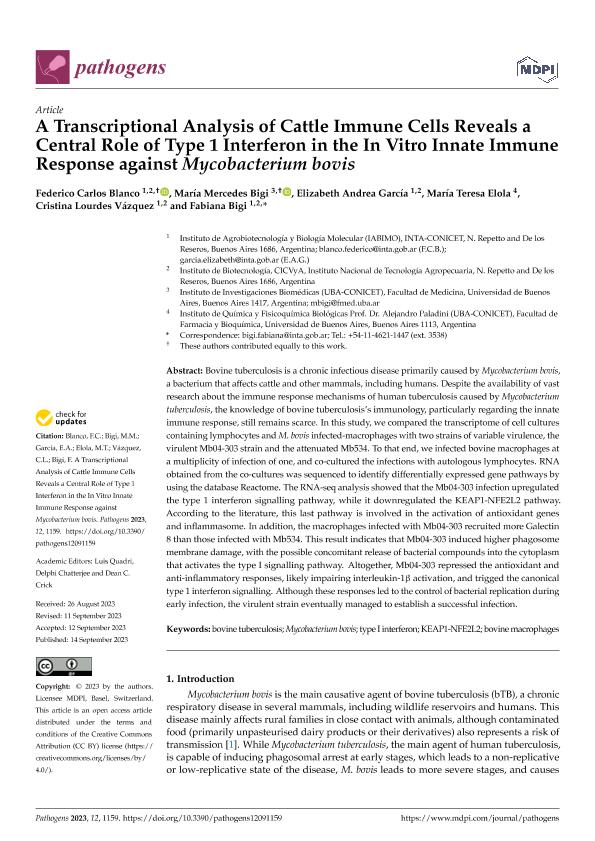Mostrar el registro sencillo del ítem
dc.contributor.author
Blanco, Federico Carlos

dc.contributor.author
Bigi, María Mercedes
dc.contributor.author
Garcia, Elizabeth Andrea

dc.contributor.author
Elola, Maria Teresa

dc.contributor.author
Vázquez, Cristina Lourdes

dc.contributor.author
Bigi, Fabiana

dc.date.available
2024-02-22T11:41:08Z
dc.date.issued
2023-09
dc.identifier.citation
Blanco, Federico Carlos; Bigi, María Mercedes; Garcia, Elizabeth Andrea; Elola, Maria Teresa; Vázquez, Cristina Lourdes; et al.; A Transcriptional Analysis of Cattle Immune Cells Reveals a Central Role of Type 1 Interferon in the In Vitro Innate Immune Response against Mycobacterium bovis; Multidisciplinary Digital Publishing Institute; Pathogens; 12; 9; 9-2023; 1-13
dc.identifier.uri
http://hdl.handle.net/11336/227964
dc.description.abstract
Bovine tuberculosis is a chronic infectious disease primarily caused by Mycobacterium bovis, a bacterium that affects cattle and other mammals, including humans. Despite the availability of vast research about the immune response mechanisms of human tuberculosis caused by Mycobacterium tuberculosis, the knowledge of bovine tuberculosis’s immunology, particularly regarding the innate immune response, still remains scarce. In this study, we compared the transcriptome of cell cultures containing lymphocytes and M. bovis infected-macrophages with two strains of variable virulence, the virulent Mb04-303 strain and the attenuated Mb534. To that end, we infected bovine macrophages at a multiplicity of infection of one, and co-cultured the infections with autologous lymphocytes. RNA obtained from the co-cultures was sequenced to identify differentially expressed gene pathways by using the database Reactome. The RNA-seq analysis showed that the Mb04-303 infection upregulated the type 1 interferon signalling pathway, while it downregulated the KEAP1-NFE2L2 pathway. According to the literature, this last pathway is involved in the activation of antioxidant genes and inflammasome. In addition, the macrophages infected with Mb04-303 recruited more Galectin 8 than those infected with Mb534. This result indicates that Mb04-303 induced higher phagosome membrane damage, with the possible concomitant release of bacterial compounds into the cytoplasm that activates the type I signalling pathway. Altogether, Mb04-303 repressed the antioxidant and anti-inflammatory responses, likely impairing interleukin-1β activation, and trigged the canonical type 1 interferon signalling. Although these responses led to the control of bacterial replication during early infection, the virulent strain eventually managed to establish a successful infection.
dc.format
application/pdf
dc.language.iso
eng
dc.publisher
Multidisciplinary Digital Publishing Institute
dc.rights
info:eu-repo/semantics/openAccess
dc.rights.uri
https://creativecommons.org/licenses/by/2.5/ar/
dc.subject
BOVINE MACROPHAGES
dc.subject
BOVINE TUBERCULOSIS
dc.subject
KEAP1-NFE2L2
dc.subject
MYCOBACTERIUM BOVIS
dc.subject
TYPE I INTERFERON
dc.subject.classification
Bioquímica y Biología Molecular

dc.subject.classification
Ciencias Biológicas

dc.subject.classification
CIENCIAS NATURALES Y EXACTAS

dc.title
A Transcriptional Analysis of Cattle Immune Cells Reveals a Central Role of Type 1 Interferon in the In Vitro Innate Immune Response against Mycobacterium bovis
dc.type
info:eu-repo/semantics/article
dc.type
info:ar-repo/semantics/artículo
dc.type
info:eu-repo/semantics/publishedVersion
dc.date.updated
2024-02-20T12:26:39Z
dc.identifier.eissn
2076-0817
dc.journal.volume
12
dc.journal.number
9
dc.journal.pagination
1-13
dc.journal.pais
Suiza

dc.journal.ciudad
Basilea
dc.description.fil
Fil: Blanco, Federico Carlos. Instituto Nacional de Tecnología Agropecuaria. Centro de Investigación en Ciencias Veterinarias y Agronómicas. Instituto de Agrobiotecnología y Biología Molecular. Consejo Nacional de Investigaciones Científicas y Técnicas. Oficina de Coordinación Administrativa Parque Centenario. Instituto de Agrobiotecnología y Biología Molecular; Argentina. Instituto Nacional de Tecnología Agropecuaria. Centro de Investigación en Ciencias Veterinarias y Agronómicas. Instituto de Biotecnología; Argentina
dc.description.fil
Fil: Bigi, María Mercedes. Consejo Nacional de Investigaciones Científicas y Técnicas. Oficina de Coordinación Administrativa Houssay. Instituto de Investigaciones Biomédicas. Universidad de Buenos Aires. Facultad de Medicina. Instituto de Investigaciones Biomédicas; Argentina
dc.description.fil
Fil: Garcia, Elizabeth Andrea. Instituto Nacional de Tecnología Agropecuaria. Centro de Investigación en Ciencias Veterinarias y Agronómicas. Instituto de Agrobiotecnología y Biología Molecular. Consejo Nacional de Investigaciones Científicas y Técnicas. Oficina de Coordinación Administrativa Parque Centenario. Instituto de Agrobiotecnología y Biología Molecular; Argentina. Instituto Nacional de Tecnología Agropecuaria. Centro de Investigación en Ciencias Veterinarias y Agronómicas. Instituto de Biotecnología; Argentina
dc.description.fil
Fil: Elola, Maria Teresa. Consejo Nacional de Investigaciones Científicas y Técnicas. Oficina de Coordinación Administrativa Houssay. Instituto de Química y Físico-Química Biológicas "Prof. Alejandro C. Paladini". Universidad de Buenos Aires. Facultad de Farmacia y Bioquímica. Instituto de Química y Físico-Química Biológicas; Argentina
dc.description.fil
Fil: Vázquez, Cristina Lourdes. Instituto Nacional de Tecnología Agropecuaria. Centro de Investigación en Ciencias Veterinarias y Agronómicas. Instituto de Agrobiotecnología y Biología Molecular. Consejo Nacional de Investigaciones Científicas y Técnicas. Oficina de Coordinación Administrativa Parque Centenario. Instituto de Agrobiotecnología y Biología Molecular; Argentina. Instituto Nacional de Tecnología Agropecuaria. Centro de Investigación en Ciencias Veterinarias y Agronómicas. Instituto de Biotecnología; Argentina
dc.description.fil
Fil: Bigi, Fabiana. Instituto Nacional de Tecnología Agropecuaria. Centro de Investigación en Ciencias Veterinarias y Agronómicas. Instituto de Agrobiotecnología y Biología Molecular. Consejo Nacional de Investigaciones Científicas y Técnicas. Oficina de Coordinación Administrativa Parque Centenario. Instituto de Agrobiotecnología y Biología Molecular; Argentina. Instituto Nacional de Tecnología Agropecuaria. Centro de Investigación en Ciencias Veterinarias y Agronómicas. Instituto de Biotecnología; Argentina
dc.journal.title
Pathogens
dc.relation.alternativeid
info:eu-repo/semantics/altIdentifier/doi/http://dx.doi.org/10.3390/pathogens12091159
dc.relation.alternativeid
info:eu-repo/semantics/altIdentifier/url/https://www.mdpi.com/2076-0817/12/9/1159
Archivos asociados
